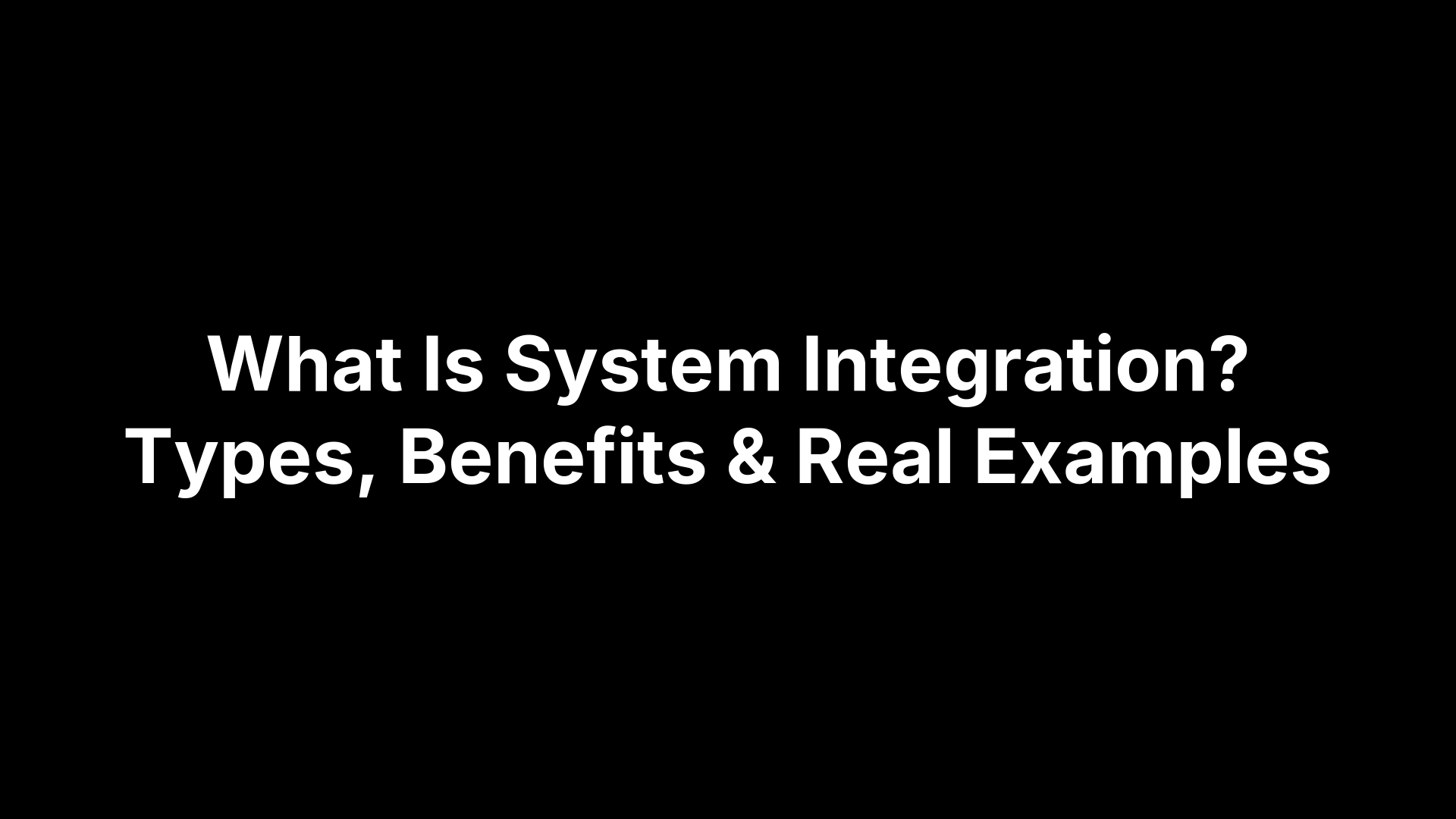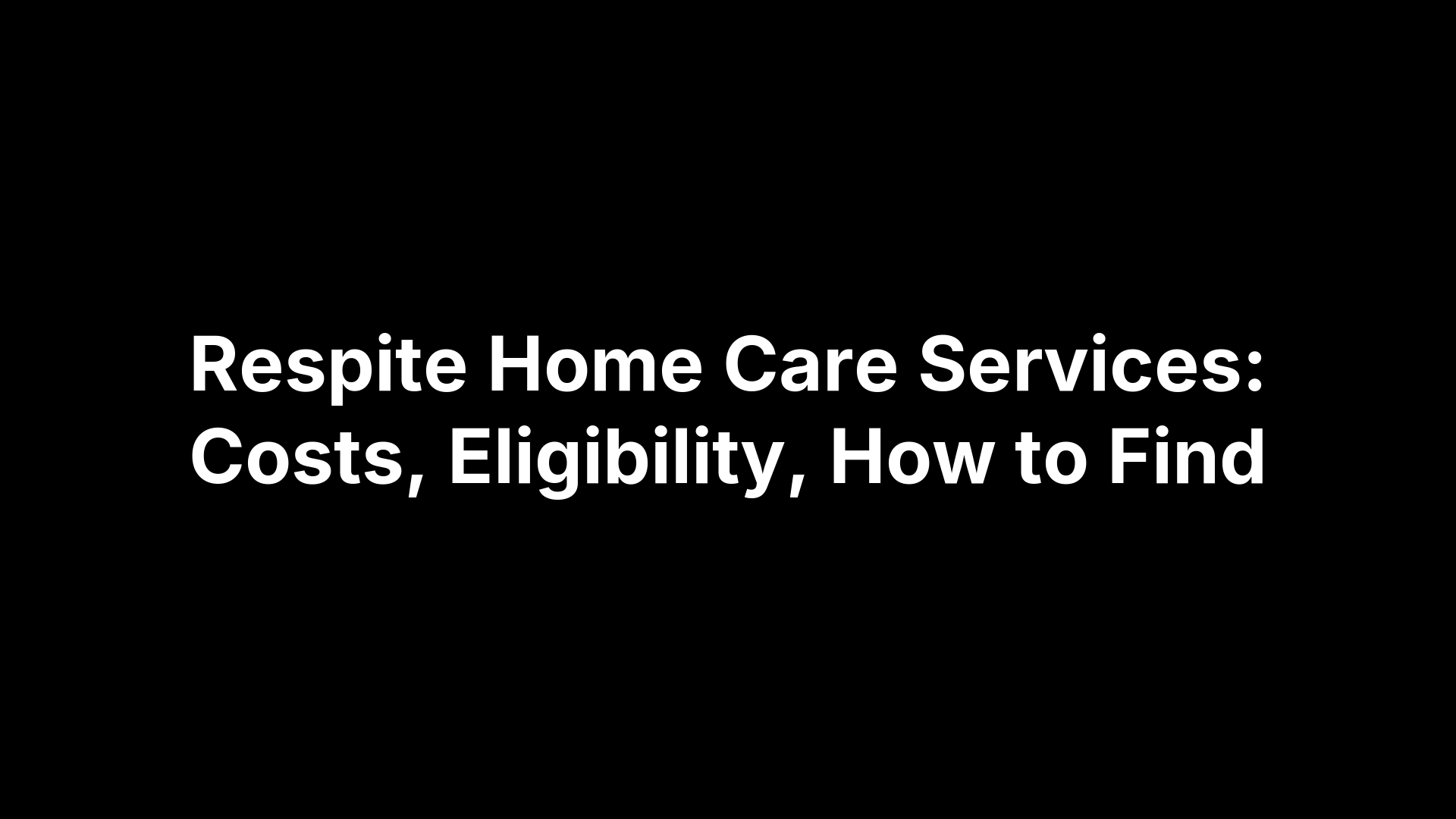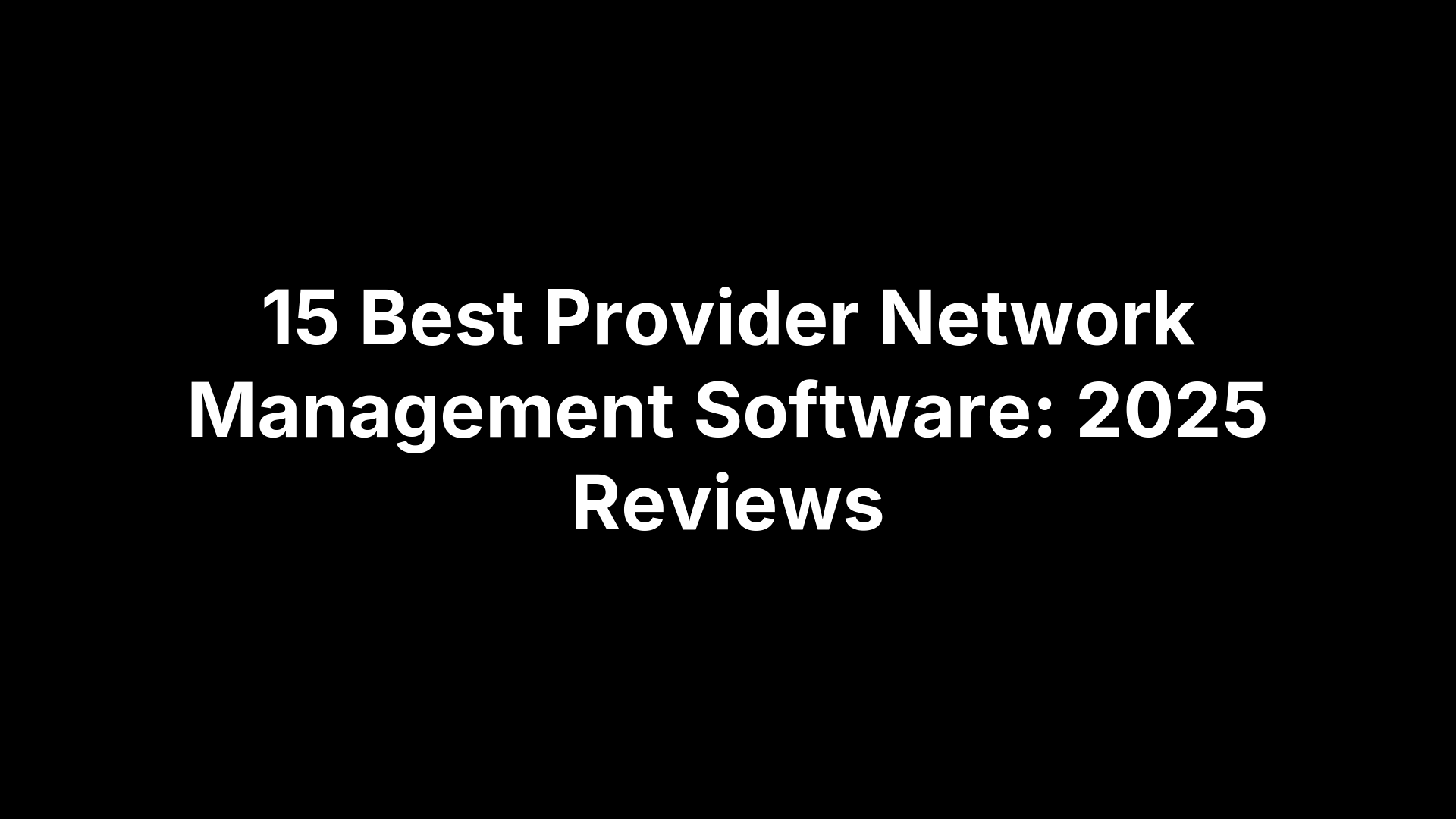What Is System Integration? Types, Benefits & Real Examples


What Is System Integration? Types, Benefits & Real Examples
System integration is the engineering and IT practice of connecting separate software, hardware, and data components into one unified, interoperable environment so they share data and processes seamlessly. Done well, it dissolves information silos, trims manual work, and arms decision-makers with a single source of truth they can trust in real time.
Keep reading to learn the four foundational integration types, the architectures that power them, and the measurable business gains they unlock. We’ll map out the full project lifecycle, flag common pitfalls, and walk through real case studies—from hospitals linking EHRs to dispatch systems, to retailers syncing online and in-store inventory—so you can judge whether, when, and how to take on an integration initiative of your own.
Why Organizations Need System Integration in 2025 and Beyond
Every team now juggles a patchwork of SaaS apps, mobile tools, IoT sensors, and decades-old on-prem systems. When those pieces can’t talk to each other, data sits in silos, employees swivel between screens, and leaders make decisions on stale reports. By unifying systems, organizations gain a single source of truth, accelerate data flow, rein in licensing and labor costs, and craft smoother customer or patient experiences. New pressures—remote work, stricter regulations, AI models hungry for clean data—make system integration a board-level priority rather than an IT nice-to-have.
Typical moments when integration pays for itself:
- Hospital linking EHR, dispatch, and billing to shorten discharge time
- Retailer syncing POS and e-commerce inventory to avoid stockouts
- Manufacturer streaming machine sensor data into ERP for predictive maintenance
- Bank exposing core-system APIs to power a mobile app without rewriting COBOL
- State agency consolidating case-management databases for real-time compliance reporting
- Logistics firm feeding GPS truck data into a customer tracking portal
Key Terms to Know Up Front
- System – a complete application or hardware platform
- Sub-system – a component inside that larger system
- Interface – the touchpoint where two systems exchange information
- Middleware – software layer (e.g., ESB) that brokers those exchanges
- API – documented set of calls that exposes system functions or data
- Data mapping – the rule set that transforms field A in one system to field B in another
The Role of a Systems Integrator
A systems integrator is an individual or firm that designs, builds, and maintains the glue between disparate technologies. They combine architecture chops, API development skills, cybersecurity know-how, and change-management savvy. Organizations hire them when in-house teams lack specific integration expertise or bandwidth to keep complex, multi-vendor environments running smoothly.
The Four Foundational Types of System Integration
Most projects can be mapped to one of four architectural patterns. Knowing which camp yours belongs to helps you scope effort, pick the right tooling, and forecast long-term maintenance. Below is the cheat sheet teams use to choose their footing before writing a single line of code.
| Type | Quick Definition | Common Use Case | Pros | Cons |
|---|---|---|---|---|
| Point-to-Point | Direct link between two systems | CRM ↔ Email platform | Fast, low cost | Becomes “spaghetti” as connections multiply |
| Vertical (Silo) | Stack of apps connected by function | Warehouse WMS + scanners + reports | Optimized for one domain | Duplicates logic across silos |
| Horizontal / ESB | Middleware bus routes messages among apps | Bank core, loan, mobile via ESB | Decouples apps; central governance | Bus can become single point of failure |
| EAI / iPaaS | Cloud hub orchestrates APIs and data flows | Retailer pipes orders through iPaaS | Scales quickly; low code | Subscription fees; vendor lock-in risk |
Point-to-Point (Star or Spaghetti) Integration
Each system talks directly to every other system it needs. Great when you have two or three apps; painful once you hit ten because the number of connections explodes according to n(n-1)/2. Small teams use it to meet a deadline, then usually replace it later.
Vertical (Silo) Integration
Think of a self-contained tower: data capture at the bottom, analytics at the top, all for one department. Finance may run its own stack separate from operations. The approach speeds deployment for a single business function but breeds duplicate data models and prevents cross-department reporting.
Horizontal Integration / Enterprise Service Bus (ESB)
Here, a middleware layer—message broker, transformation engine, security gateway—routes and translates traffic. Applications publish to the bus, which then delivers messages to subscribers. ESBs reduce direct dependencies, simplify onboarding new apps, and centralize policy enforcement, but they demand rigorous governance to avoid bottlenecks.
Enterprise Application Integration (EAI) & iPaaS
Modern EAI lives in the cloud as Integration-Platform-as-a-Service. Vendors provide prebuilt connectors, drag-and-drop mapping, and event orchestration so teams can integrate SaaS, mobile, and on-prem systems without deep coding. It’s ideal for hybrid environments and rapid experimentation; just watch contract terms and data residency requirements.
Common Integration Approaches & Architectures
When people ask what is system integration, the answer usually starts with “connect the APIs.” In reality, teams mix and match several approaches depending on latency needs, data volume, and technical debt. The matrix below captures the trade-offs at a glance.
| Approach | Data Timeliness | Typical Tools/Tech | Core Strength | Primary Risk |
|---|---|---|---|---|
| Batch ETL/ELT | Hours–days | SQL scripts, Spark, cloud data pipelines | Moves huge historical data sets cheaply | Not suitable for operational decisions |
| Real-Time API | Seconds | REST/JSON, GraphQL, gRPC | Fine-grained control, widely supported | Versioning & authentication complexity |
| Event-Driven | Sub-second | Kafka, AWS Kinesis, MQTT | Scales to millions of messages | Requires new ops skills & monitoring |
| Service-Oriented / Microservices | Milliseconds | Containers, service mesh, gRPC | Loose coupling, independent deploys | Network chatter; distributed tracing needed |
| RPA Screen Scraping | Minutes | UiPath, Power Automate | No code changes to legacy apps | Brittle; UI tweaks break bots |
Most organizations layer two or more of these patterns so data lands where it’s needed without drowning systems in unnecessary traffic.
API-Led Connectivity
Here the API is the product. Each system exposes a versioned REST or GraphQL interface guarded by OAuth 2.0 or JWT, and other apps consume it through well-documented contracts. Example: a payroll platform pushes new-hire data to the HR portal via POST /employees. Strong governance and reusable “experience,” “process,” and “system” APIs keep sprawl in check.
Middleware & ESB
An Enterprise Service Bus (or its cloud cousin) sits in the middle, handling routing, transformation, and protocol translation. Tools such as MuleSoft or RabbitMQ convert EDI files to JSON, enforce schemas, and log every hop, giving ops teams a single choke point for policy and observability.
Data Integration & ETL/ELT Pipelines
When analytics teams need millions of historical rows, speed of movement trumps immediacy. ETL jobs extract data overnight, transform it into a canonical model, and load it into a warehouse like Snowflake or BigQuery. ELT flips that order by transforming inside the warehouse, reducing staging infrastructure.
Event-Driven & Streaming Integration
Publish/subscribe models broadcast tiny messages the moment something happens—a blood-pressure spike, an online order. Producers write to a topic; consumers react asynchronously. Back-pressure handling, idempotency, and replayable logs make platforms such as Kafka ideal for IoT and real-time alerting while minimizing tight coupling between producers and consumers.
Tangible Business Benefits of Successful Integration
Pulling systems together is rarely just an IT vanity play; it moves real dollars and delight. When disconnected apps finally share data through a well-designed integration fabric, organizations shave hours off routine tasks, trust their metrics, and gain the agility to launch new services without ripping out legacy tech. Below are the five payoffs executives cite most often after a project goes live.
Operational Efficiency & Cost Savings
- 70-90% reduction in manual data entry by eliminating “swivel-chair” work
- Fewer licensing fees as redundant apps and shadow spreadsheets disappear
- One large hospital we worked with cut average patient-transport scheduling time from 20 minutes to under 2, saving more than $500K in annual labor and bed costs
Data Accuracy & Single Source of Truth
Integrations apply real-time validation and master-data rules, so duplicate records are quashed at the gate. Finance trusts revenue numbers, clinicians see the same allergy list, and auditors trace every change with full lineage, reducing compliance penalties.
Faster Decision-Making & Analytics
With live APIs feeding dashboards instead of overnight CSV drops, leaders react on the same day—sometimes the same minute. Predictive models run on a streaming layer, flagging stockouts or sepsis risk before they happen and turning insights into clicks instead of slide decks.
Enhanced Customer/Patient Experience
Unified data means no more “Let me put you on hold while I look that up.” Call centers view shipment status, payment history, or discharge plans in one pane of glass, slashing average handle time and boosting Net Promoter Scores by double digits.
Scalability & Future-Proofing
A modular, API-first architecture lets teams bolt on new SaaS apps, AI engines, or IoT devices without rewriting the core. That flexibility shortens time-to-market for new products and shields the business from vendor sunsets or regulatory curveballs.
The System Integration Lifecycle: From Planning to Maintenance
Successful projects follow a predictable arc. Skipping a phase almost guarantees scope creep or post-go-live outages, so treat the lifecycle as a checklist—finish one gate before racing to the next. Below is the six-step roadmap most integrators use, whether they are wiring two SaaS apps or a nationwide hospital network.
1. Requirements & Feasibility Analysis
Start with discovery workshops, stakeholder interviews, and an inventory of every application, interface, and data element in play. Define measurable KPIs—latency < 2 s, 99.9 % uptime, 0 duplicate patient IDs—that will judge success. A quick technical spike or proof of concept validates that the desired data is actually accessible.
2. Solution Design & Architecture
Architects now translate business goals into diagrams: choose integration type (API-led, ESB, streaming), map canonical data models, and lay down security baselines (TLS 1.3, OAuth 2.0 scopes, role-based access). Governance artifacts—naming conventions, versioning strategy, change-control board—are documented here, not after coding begins.
3. Development & Configuration
Engineers build or configure connectors, develop REST endpoints, set up middleware, and create data-mapping rules. Low-code iPaaS flows might replace hand-rolled scripts, but code repositories and CI/CD pipelines still enforce style checks, static-analysis scans, and automated unit tests.
4. Integration Testing & Validation
Testing moves beyond “does it compile?” to “does the ecosystem behave?” Teams execute unit, system, regression, performance, security, and formal System Integration Testing (SIT). Simulated payloads and synthetic users hammer the stack while data-quality tools flag mismatched schemas or out-of-range values.
5. Deployment & Change Management
Rollout options include big-bang, phased, or parallel deployments. Whichever you pick, line up user training, updated SOPs, back-out plans, and communication playbooks so call centers aren’t blindsided. Feature flags or blue-green environments let you toggle traffic gradually and monitor impact.
6. Ongoing Monitoring, Support & Optimization
Post-launch, DevOps dashboards track latency, message error rates, and throughput against the KPIs set in step 1. Logs flow to centralized SIEMs; APM tools trigger alerts before users complain. Quarterly health checks and capacity reviews keep the integration fabric secure, compliant, and ready for new requirements.
Real-World Examples Across Industries
Client names are under NDA, but the composite stories below illustrate how strategic system integration delivers measurable wins—no matter the sector.
Healthcare: Linking EHR, Dispatch, and Billing
A regional hospital wired its electronic health record (EHR), non-emergency transport dispatch, and billing platform through an API-led hub. Discharge orders now push directly to dispatch; trip status flows back to the EHR; mileage and wait times auto-populate invoices. Result: average discharge-to-door time fell from 5 hours to 90 minutes and billing errors dropped 22 %.
Retail: Unified Inventory Between POS and E-Commerce
A specialty retailer replaced nightly CSV uploads with real-time event streaming between point-of-sale (POS) terminals and its Shopify storefront. When a shirt is scanned at checkout, a Kafka topic updates online stock within 300 ms; web orders reverse the flow. The integration cut overselling to virtually zero and freed two analysts from manual reconciliation.
Finance: Core Banking System & Mobile App Integration
A mid-size bank exposed decades-old COBOL services through a secure API gateway, feeding a new mobile app without touching core code. Customer balance, ACH status, and card controls ride JSON over OAuth 2.0, while rate-limited queues protect the mainframe. The bank launched the app in six months and saw a 38 % surge in digital engagement.
Manufacturing & IoT: Factory Floor Sensors to ERP
Plant-floor PLCs publish temperature and vibration data to an MQTT broker; a microservice then flags anomalies and raises work orders in the ERP. Predictive maintenance moved unplanned downtime from 4 % to under 1 % of production hours, saving roughly $750 k in annual scrap and overtime.
Government & Public Safety: CAD, GIS, and Radio Systems
A county 911 center integrated its Computer-Aided Dispatch (CAD), GIS mapping, and digital radio network with a middleware bus. Call data, unit GPS, and traffic layers merge into one console, while status messages auto-synchronize across radios and MDTs. Average dispatch time shrank by 18 seconds—a critical margin when lives are on the line.
Challenges, Risks, and Proven Best Practices
No integration project is risk-free. Scope balloons, data formats clash, and a single misconfigured permission can expose millions of records. The table below sums up the headaches teams meet most often—and the moves that usually neutralize them.
| Challenge | Mitigation |
|---|---|
| Fuzzy business requirements | Lock requirements in a living specification; tie each to a KPI. |
| Dirty or duplicate data | Run profiling tools early; cleanse and master before first payload. |
| Over-customized point-to-point links | Favor reusable APIs or an ESB/iPaaS hub; enforce design standards. |
| Performance bottlenecks at scale | Load-test with production-like data; add caching and autoscaling. |
| Security gaps (weak auth, open ports) | Adopt “zero-trust” defaults: TLS everywhere, OAuth scopes, least privilege. |
| Lack of post-go-live ownership | Assign an integration product owner and 24/7 support rotation. |
Common Pitfalls
Even seasoned teams slip on a few banana peels: underestimating data-quality fixes, skipping end-to-end testing, and letting “just one more field” requests derail timelines. Create a change-request log, freeze scope after design sign-off, and budget at least 20 % of effort for data remediation to stay on track.
Security & Compliance Considerations
Sensitive data now travels farther, so every hop must be encrypted and auditable. Use tokenized identifiers, rotate keys automatically, and log access in a tamper-evident store. Map each data flow to its compliance regime—HIPAA, GDPR, PCI—and bake those controls into CI/CD gates, not retrofits.
Governance, Documentation, and Change Control
Treat integration assets as products: version your APIs, publish schemas to an internal catalog, and require pull-request reviews for mapping changes. A lightweight architecture board can arbitrate breaking changes and sunset plans, preventing “shadow” endpoints from multiplying.
Selecting the Right Tools and Partners
Score vendors on five factors: scalability, open standards support, security certifications, total cost of ownership, and roadmap alignment with your industry. Demand proof-of-concept results and customer references before signing, and insist on exit clauses to avoid long-term lock-in.
Key Takeaways on System Integration
System integration isn’t just an IT project—it’s a business multiplier. Connect the right dots and you unlock cleaner data, faster workflows, and new revenue opportunities.
- Know what you’re solving. Define success metrics and pick the matching pattern—point-to-point, vertical, horizontal/ESB, or cloud iPaaS—before writing code.
- Think API-first, but mix methods wisely. Combine real-time APIs, batch pipelines, and event streams so each dataset travels at the speed its use case demands.
- Value lives in the outcomes. Expect lower operating costs, a single source of truth, quicker decisions, and happier customers or patients when integrations fire reliably.
- Follow the six-step lifecycle. Requirements → design → build → test → deploy → monitor; skipping a gate nearly always costs more later.
- Guard against common pitfalls. Dirty data, scope creep, weak security, and ownerless maintenance are the usual culprits—plan controls up front.
Ready to simplify healthcare integrations? Explore how VectorCare can stitch your EHR, dispatch, and billing systems together without the headache.
The Future of Patient Logistics
Exploring the future of all things related to patient logistics, technology and how AI is going to re-shape the way we deliver care.



